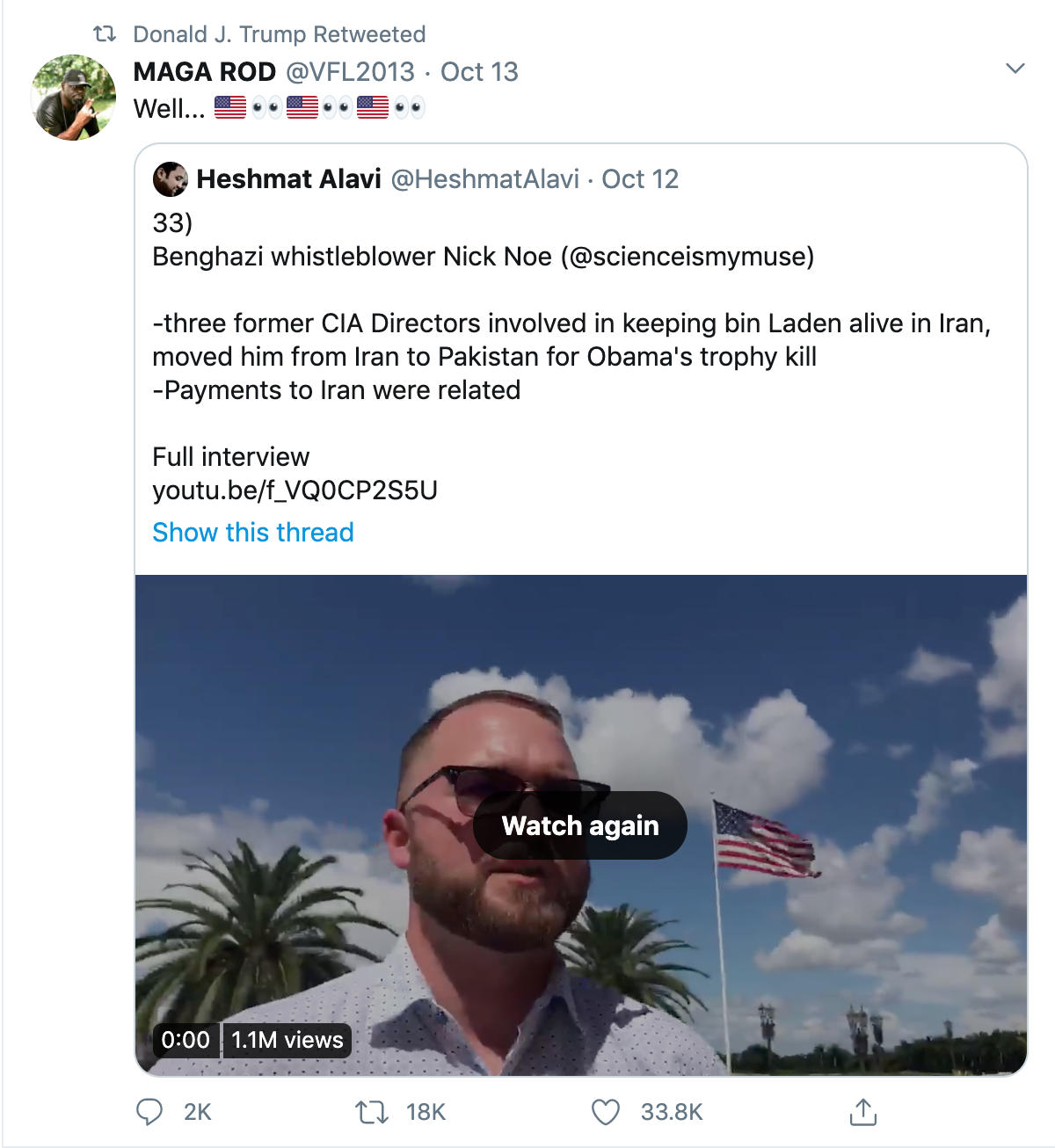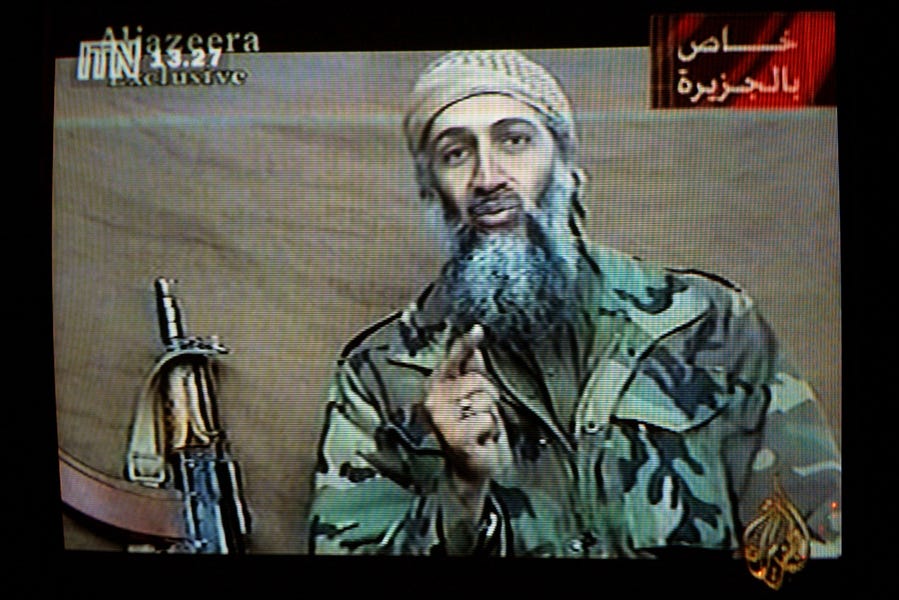I had intended to write this week about North Korea’s provocative missile display, or China’s role in facilitating the opioid crisis inside the U.S., but both of those topics will have to wait. Earlier this week, a conspiracy theory went viral. It gained traction, in large part, because President Trump retweeted it.

While it is generous to call it a “theory,” it goes something like this: The CIA and the Obama administration conspired to cover up Osama bin Laden’s presence in Iran. The U.S. then paid Iran to release bin Laden to Pakistan, so that President Obama could manufacture the triumphal raid in Abbottabad in May 2011. In other words, bin Laden’s presence in Abbottabad wasn’t discovered after years of sleuthing by the CIA. Instead, the whole bin Laden raid was a staged affair for political purposes. And here’s the kicker: Obama had members of Navy SEALs Team Six, which conducted the raid, assassinated to cover up the conspiracy.
This is, in a word, nonsense.
For starters, the Navy SEALs who conducted the raid dispute the claim that they are dead. One of them, Robert O’Neill, is a prominent Trump supporter and active on Twitter. O’Neill claims he personally shot and killed bin Laden. After Trump retweeted the conspiracy theory, O’Neill expressed his disapproval:
Beyond the lack of any actual evidence, there is another basic problem with this story: Its peddlers cannot even keep their central plot straight.
The story was “sourced,” such as it is, to a man named Nick Noe, who claims to be the Benghazi whistleblower. In an interview posted October 12 on YouTube, and which has more than 400,000 views, Noe doesn’t claim to have any firsthand evidence regarding the bin Laden raid. Noe simply relays what he “heard” from others. In one version of the story Noe claims to have heard, bin Laden wasn’t really killed at all. The SEALs supposedly killed a “body double” who only appeared to be bin Laden.
Now, one does not need to be a master logician to spot the contradiction. If the SEALs killed a body double, then why would the Obama administration need to pay the Iranians to ship the real bin Laden to Pakistan for a “trophy kill” (Noe’s words)? The “body double” claim would also come as a surprise to al-Qaeda, which publicly mourned the passing of its founder and vowed revenge. Obviously, both versions of the story Noe “heard” can’t be true. Indeed, neither version is true.
You might be wondering, why should we spend any time on such rubbish? Besides the fact that President Trump gave the conspiracy a significant boost on Twitter, it is an example of how outright idiocy can quickly drown out facts. Given the number of retweets and likes, I’d wager that more people have been exposed to this rubbish than have heard or read a far more accurate version of the story concerning al-Qaeda’s complex relationship with Iran. That is one of the real dangers in our disinformation age—bogus claims can taint or discredit legitimate issues that deserve careful scrutiny.
O’Neill and the Navy SEALs who carried out the bin Laden raid—and who are still alive—scooped up a vast treasure trove of documents and media inside the compound. Steve Hayes and I have reported on that trove, and agitated for its release, for years. Most of the files were released in 2017 due to our efforts. Most importantly, the files showed that Osama bin Laden spent the last years of life overseeing a global terror network—from inside Pakistan, not Iran.
The bin Laden files proved to be a crucial source of intelligence. The documents and media were used to identify and hunt down al-Qaeda operatives, revise the U.S. government’s flawed model for understanding how the group works, and garner terrorist convictions in Western courts, among other uses. Iran is one of the subjects that is discussed with regularity in the files.
While bin Laden didn’t live inside Iran, many of his family members did. And during the last year of his life in Abbottabad, bin Laden worried repeatedly about their fate, especially his young son Hamza. Like other al-Qaeda men and women, Hamza fled to Iran after 9/11. Hamza was married while there, and his wedding video was among the files seized in Abbottabad. (In 2017, I helped convince the CIA to release Hamza’s wedding video to the public.) At times, Hamza and other al-Qaeda men enjoyed a loose house arrest inside Iran. But eventually the issue became contentious. Osama and his lieutenants discussed ways to force the Iranians to free a number of al-Qaeda operatives. At one point, they kidnapped an Iranian diplomat in order to force an exchange. Osama also instructed his right-hand man, Atiyah Abd al-Rahman, to be wary of bin Laden family members returning from Iran because they may be tracked. Rahman perished in the drone campaign months after bin Laden’s death. And Hamza was eventually tracked down as well.
The Abbottabad files also show that bin Laden was worried about Iran’s expanding influence throughout the Middle East and thought of ways to combat it. Al-Qaeda and Iran have been at odds in multiple ways, including during the wars in Iraq, Syria, and Yemen. Yet, duplicity is the name of the game. And al-Qaeda’s founder surmised that it was better to avoid a direct confrontation with the Iranians. When the head of the Islamic State of Iraq, an al-Qaeda-affiliated group, threatened to attack Iran in 2007, bin Laden sent a disapproving note. Bin Laden wrote:
You did not consult with us on that serious issue that affects the general welfare of all of us. We expected you would consult with us for these important matters, for as you are aware, Iran is our main artery for funds, personnel, and communication, as well as the matter of hostages.
That’s worth pausing on for a moment. Some top intelligence officials had long believed that al-Qaeda and Iran would never cooperate because of religious differences. But in this letter, bin Laden himself described Iran as al Qaeda’s “main artery” for sustenance and growth. That “main artery” was a facilitation network led by an al-Qaeda operative known as Yasin al-Suri (also known as Yasin al-Kurdi). I found al-Suri’s personnel file in the Abbottabad trove released by the CIA. The biography notes that he was based in Iran.
The U.S. Treasury Department designated Yasin al-Suri as a terrorist in July 2011. The Treasury and State Departments further exposed the al-Qaeda network inside Iran in a series of subsequent designations and other official statements. The U.S. government found that this “core facilitation pipeline” operates under an agreement between al-Qaeda and the Iranian regime. Al-Suri and others shuttled cash, personnel, and messages through Iranian soil, with the blessing of Tehran.
Other senior al-Qaeda leaders—but not Osama bin Laden—have been based inside Iran as well. Two of them are known as Saif al-Adel and Abu Mohammad al-Masri, both of whom have been wanted by the U.S. since the 1990s. The State Department has issued a reward of up to $10 million for information on their specific whereabouts, but it is well known that they are inside Iran.
There’s much more to this story. But the bottom line is this: Instead of talking about the very real evidence showing that the Iranian regime has reached accommodations with al-Qaeda, despite their ideological and tactical differences, tens of thousands of people were exposed to an asinine conspiracy theory this week. And the president of the United States helped spread it.
Photograph from Getty Images.






Please note that we at The Dispatch hold ourselves, our work, and our commenters to a higher standard than other places on the internet. We welcome comments that foster genuine debate or discussion—including comments critical of us or our work—but responses that include ad hominem attacks on fellow Dispatch members or are intended to stoke fear and anger may be moderated.
With your membership, you only have the ability to comment on The Morning Dispatch articles. Consider upgrading to join the conversation everywhere.